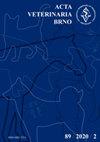Monitoring the redox status in dairy cows by using plasma dROMs, PAT, and OSI biomarkers
IF 0.7
4区 农林科学
Q3 VETERINARY SCIENCES
引用次数: 0
Abstract
The aim of this work was to determine the changes of redox indicators such as reactive oxygen metabolites (dROMs), plasma antioxidant test (PAT) and the oxidative stress index (OSI) in dairy cows at different stages of lactation using a diagnostic equipment which is suitable for in vivo oxidative stress (OS) monitoring procedures. In total, 628 dairy cows were examined in the pre-parturient period (days in milk [DIM]: -21 to -1 day; n = 117), in the calving and maternity period (DIM: 0 to 7; n = 137), in the early lactation period (DIM: 8 to 30; n = 139), and the in the peak lactation (DIM: 31 to 150; n = 235). The dROMs and OSI values were significantly different (P < 0.05) when comparing the 1st and 2nd+ lactation cows in each group. The highest mean value of dROMs was detected at the calving and maternity stage in 1st lactation cows (141 ± 25 U. Carr) and the lowest (103 ± 29 U. Carr) was found in peak lactation. The OSI developed similarly, with the highest value of 5.58 ± 0.94 in the calving and maternity period in the 1st lactation cows and the lowest value of 4.05 ± 1.21 in peak lactation and significant differences were found in many cases. Based on the results, the measurement of dROMs and OSI may be suitable for detecting oxidative stress in different lactation stages.利用血浆dROMs、PAT和OSI生物标志物监测奶牛氧化还原状态
本工作的目的是使用适用于体内氧化应激(OS)监测程序的诊断设备,测定奶牛在不同泌乳阶段的氧化还原指标,如活性氧代谢产物(dROM)、血浆抗氧化试验(PAT)和氧化应激指数(OSI)的变化。总共有628头奶牛在临产前(产奶天数[DIM]:-21至-1天;n=117)、产仔期和产期(DIM:0至7;n=137)、泌乳早期(DIM:8至30;n=139)和泌乳高峰期(DIM:31至150;n=235)接受了检查。各组泌乳1、2期奶牛的dROM和OSI值比较有显著性差异(P<0.05)。dROMs的平均值在第一泌乳奶牛的产仔期和产仔期最高(141±25 U.Carr),在泌乳高峰期最低(103±29 U.Carr)。OSI也有类似的发展,在第一泌乳奶牛的产仔期和产期最高值为5.58±0.94,在泌乳高峰期最低值为4.05±1.21,在许多情况下发现了显著差异。基于这些结果,dROM和OSI的测量可能适用于检测不同泌乳阶段的氧化应激。
本文章由计算机程序翻译,如有差异,请以英文原文为准。
求助全文
约1分钟内获得全文
求助全文
来源期刊

Acta Veterinaria Brno
农林科学-兽医学
CiteScore
1.00
自引率
33.30%
发文量
36
审稿时长
18-36 weeks
期刊介绍:
ACTA VETERINARIA BRNO is a scientific journal of the University of Veterinary and Pharmaceutical Sciences in Brno, Czech Republic.
The scientific journal Acta Veterinaria Brno is dedicated to the publication of original research findings and clinical observations in veterinary and biomedical sciences. Original scientific research articles reporting new and substantial contribution to veterinary science and original methods that have not been submitted for publication elsewhere are considered for publication. A written statement to this effect should accompany the manuscript, along with approval for publication by the author´s head of department. The authors bear full responsibility for the contents of their contribution. Book reviews are published, too.
 求助内容:
求助内容: 应助结果提醒方式:
应助结果提醒方式:


